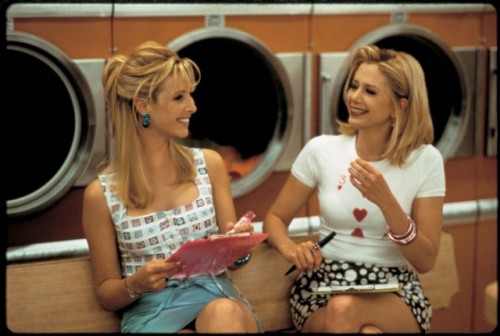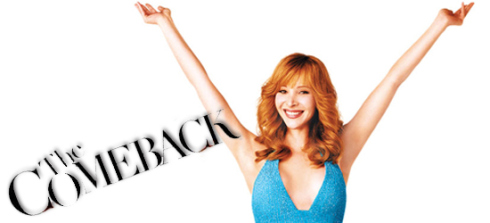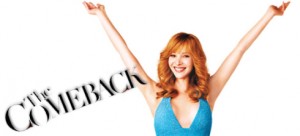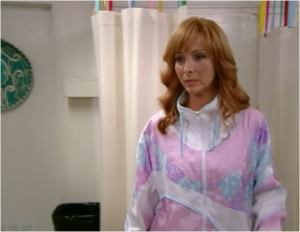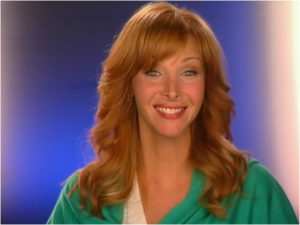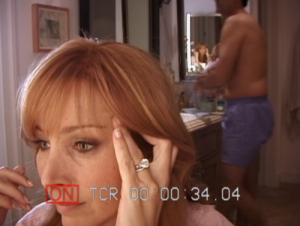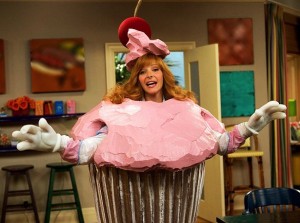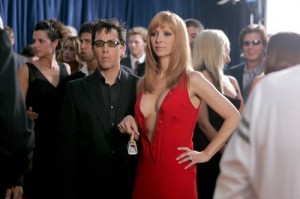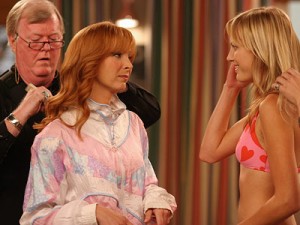This guest post by Emma Kat Richardson appears as part of our theme week on Female Friendship.
“God, sometimes I wish I were a lesbian.”
“You wanna try having sex sometime, just to see if we are?”
Romy pauses to consider, then scoffs dismissively. “Yeah right Michele, just the thought of having sex with another woman creeps me out.” Then, an afterthought. “…but if we’re not married by the time we’re 30, ask me again.”
Romy and Michele’s High School Reunion was released theatrically in 1997. Presumably at the time, the titular characters – beloved besties, roomies, and even, rather shockingly, bunkies in twin beds – were around 27 or 28 years old. Which would, in 2014, make them both either 44 or 45. Have they done it yet? By this time, I’m even hoping for a marriage license.
Any ‘90s girl worth her weight in Polly Pockets is bound to be intimately familiar with this movie. My first encounter with the duo happened at a sleepover, in middle school. One trip to the video store and credit card swipe from a friend’s “cool mom” later (you know, the kind not deterred by a pesky R rating), and I was suddenly plunged neck deep into the world of gaudy pink boas and four letter words. Admittedly, much of the humor was over my young, inexperienced head – there’s a recurring joke about a male character schlepping around a giant notebook to conceal his erection whenever Michele is around, which I assumed was just a zing at a nerds and their wacky obsession with doing homework. But there was much to love in the brassy confidence, bold aesthetic choices, and chirpy self-empowerment in the two heroines, and it’s this aspect of RMHSR that makes it one of the most important female-driven comedies.
As high school compadres living together in a sizable beachfront Los Angeles apartment (paid for, somehow, by Romy’s cashier salary alone), Romy and Michele are played with aplomb by Mira Sorvino and Lisa Kudrow, respectively. Through a chance encounter with a former classmate from Tuscon (Heather Mooney – a breakout role for the indomitable Janeane Garofalo) the pair finds out that their 10-year high school reunion is coming up, providing the perfect opportunity to stun adolescent tormenters with their adult impressiveness.
There’s just one problem: their lives aren’t terribly impressive. In fact, on paper, they’re kind of losers. Quite literally, on paper – filling out a pre-reunion questionnaire reveals some startling facts to the blissfully ignorant pair: both are in their late 20s, still single, and stuck in menial jobs. Or no job at all, in Michele’s case. Worse still, a clique of popular mean girls from their teen years, the A Group, is bound to show up at the reunion, along with Romy’s senior year crush, a good-looking meathead who agrees to dance with her at the prom, and then disappears with his wicked girlfriend, the alpha of the A Group. Naturally, there’s a bit of pressure to get appearances here just right. What’s the point of going if you’re not going to impress people, Romy moans.
The answer to this sticky situation, it turns out, is to fight sticky with sticky notes. Why not say they invented Post-Its? Roll into town with a “flip phone” in hand (oh, the ‘90s!), conservatively attired in homemade business suits….Everybody’s bound to believe this incredible fib, right? Wrong. This being a warm and friendly comedy, the nature consequence of grandiose foolery is the spectacular flameout.

While there’s quite a bit that’s frivolous about Romy and Michele – the film’s tagline is “The Blonde Leading the Blonde” – there is also, much more importantly, the heartwarming love story at the film’s creamy center. But this love has nothing to do with the complications and disappointments that romantic relationships can bring; rather, it’s what the Greeks called agape, or a deeply spiritual, passionate love between intimate friends. Romy White and Michele Weinberger are heterosexual, and to some degree obsessed with their appearances. Who could forget the sensational mid-movie argument scene; yelling “I’M THE MARY, YOU’RE THE RHODA!” at a friend is still a thing to this day. And yet, it’s the friendship between Michele and Romy that transcends the bounds of what a typical female interaction on screen ought to be, by conventional standards.
Together, the two women draw strength from each other: they face down the members of the A Group in the film’s climactic scene, and in the process expose the cruel, manipulative version of “friendship” that so often plays out in movies. In confronting Christie Masters, a prototype of Mean Girls’ Regina George, Romy and Michele gain a sense of self-actualization by exposing her for the insecure, jealous, hateful person always found at the rotted core of an aggressive, abusive bully. Less-than-princely men are, too, an obstacle of no legitimate threat to the relationship maintained by the duo. As Romy tries and fails to secure reunion-ready boyfriends for them in some of the film’s establishing scenes, she repeatedly strikes out, or finds excuses not to follow through on leads. (“Would you excuse me?” she tells a man at a club, “I cut my foot before and my shoe is filling up with blood.”) One has to wonder if the women might not be intentionally single – after all, aren’t they really the loves of each other’s lives? Their sense of inter-personal connectivity is so ingrained that even a dance with a lover is impossible without the other. “May I have this dance?” Sandy Frink, the aforementioned notebook carrier, gingerly asks the grown up Michele at the reunion. “Only if Romy can dance with us,” is the answer, and it’s hard to imagine such a request being met with any other outcome.
Amid so much calculated superficiality among female friendships portrayed on screen, now, even more than 10 years later, it’s still wonderfully refreshing to watch a movie with such a strong girl-powered relationship at its central focus. Romy and Michele are themselves far from perfect, but that’s the whole point: perfection can never be a substitute for true happiness, itself a thing derived from real love in its most unadulterated sense. The lessons of Romy and Michele’s High School Reunion are pure and positive: the love between friends is a potent force against the evils of the world, and remaining faithful to one’s self is the derivative of uncomplicated happiness. Take a lesson, here, and whether you think you’re the Mary or the Rhoda, always do your best to have a Romy and Michele day.

Emma Kat Richardson is a Detroit-reared freelance writer living in Austin, Texas. Her work has appeared in Bitch, Laugh Spin Magazine, 944, Alternative Press, Real Detroit Weekly, and on Bust.com. Tweet her: @emmakat, and read her: emmakatrichardson.com.
